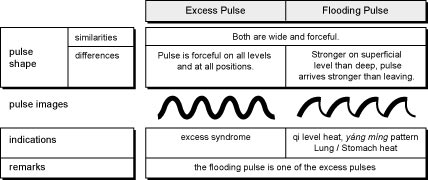The Flooding, Surging, Overflowing Pulse (Hong Mai)

Flooding Pulse (?? Hong Mai, surging, overflowing)
Key points: forceful, wide, comes stronger than going
Indications: qi level heat (wen bing, four levels), yang ming jing bing (Shang Han Lun), or Lung and Stomach heat (zang fu). All three of these pathologies are describing the same presentation.
This pulse represents excess heat (comes strong) with damage to qi and fluids (leaves weak).
Explanation: there is a set of diagnostic findings that comes from the Shang Han Lun and Wen Bing schools of thought called the “Four Bigs”. These four “big” findings are the big fever, sweating, thirst, and pulse. The Bensky formula text calls these symptoms the “Four Greats”. Essentially, this is an illness that causes a high fever. The extreme heat of the high fever generates greater blood movement (as heat does) resulting in the force and width of the flooding pulse. However this high fever causes sweating which depletes the body of qi and yin. When there is an underlying deficiency of yin, there comes the “big thirst”. With the developing qi deficiency, there is a weakness in the pulse. So, the flooding pulse comes strong (excess heat) but leaves weak (qi and yin damage).
Because yang is “up” and yin is “down”, you could also say that the pathogenic heat (yang in nature) is still strong and as such, the rising aspect of the pulse wave is excessive. The descending aspect of the pulse would hence be related to yin, which has been damaged due to the high fever (heat damages yin) and sweating (fluid loss naturally depletes qi and yin) and as such is weaker and/or thinner on the descending side of the pulse wave.

The Flooding Pulse

Comparison of Excessive and Flooding Pulses

Comparison of Large and Flooding Pulses
Next: livin’ large.
 Last modified: July 30, 2009
Last modified: July 30, 2009  Tags: Diagnosis, Palpation В· Posted in: Pulse Class, Pulse-Palpation
Tags: Diagnosis, Palpation В· Posted in: Pulse Class, Pulse-Palpation
